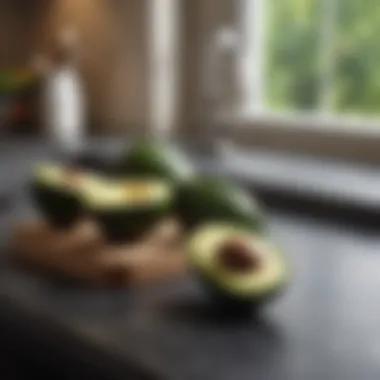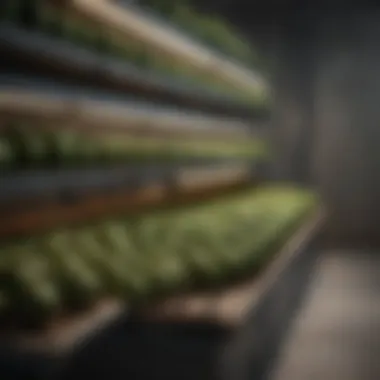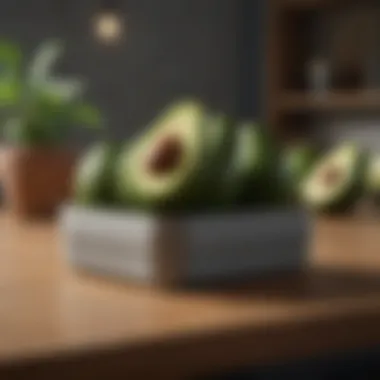Maximize Avocado Freshness with Smart Storage


Intro
Avocados are a popular fruit known for their creamy texture and rich flavor. They are not only delicious but also packed with nutrients, making them a staple in many diets. However, storing avocados properly can be a challenge. Mismanagement of their storage can lead to overripening or spoilage. This article examines crucial factors affecting avocado storage, such as their ripening process, ideal temperature conditions, and effective storage techniques. By understanding these elements, individuals can enjoy avocados at their peak freshness, maximizing their shelf life without sacrificing quality.
Design Inspiration
The way we choose to integrate storage solutions for avocados within our home is often overlooked. While avocados themselves are not a design element, the methods used to store them can reflect personal style and practicality.
Trending Styles
Modern kitchen designs are increasingly focused on functionality combined with aesthetics. Open shelving, for instance, has gained popularity. Here, avocados can be beautifully displayed alongside other fruits and vegetables, promoting a fresh kitchen atmosphere.
- Farmhouse Style: Rustic wooden crates can hold avocados, providing a friendly, cozy look. This style promotes easy access while enhancing the room's charm.
- Minimalist Approach: A sleek glass container may offer a modern touch, showcasing the avocados without additional clutter.
- Eco-Friendly Ideas: Repurposed materials can create useful storage solutions. Consider using old glass jars to keep avocados visible and accessible.
Color Palettes
Incorporating avocados into your kitchen decor can also be achieved through color selection. The rich green hues of avocados can harmonize well with complementary shades.
- Natural Greens and Earth Tones: Incorporating muted greens with browns can evoke a calming, natural atmosphere.
- Bold Contrast: Deep green avocados can contrast beautifully with bright white or even vibrant orange elements.
Storing avocados should reflect both practicality and style. This not only keeps the fruit fresh but also enhances the aesthetic appeal of the space.
Practical Tips
Practicality is essential when dealing with avocados. Knowledge in this area can prevent waste and ensure high quality.
Maintenance & Care
Keeping avocados fresh requires attention. Here are essential guidelines:
- Check Ripeness Regularly: Assess an avocado's ripeness by gently squeezing it. If it yields slightly, it's ripe. Overripe fruit can not be salvaged.
- Store Whole Avocados: If unripe, store them at room temperature. This encourages natural ripening.
- Refrigeration: Once ripe, avocados can be stored in the refrigerator. The cold slows down further ripening and extends their freshness.
Budgeting & Planning
Understanding how to effectively budget for avocados can prevent overspending and waste:
- Purchase Timing: Avocados are often cheaper in bulk or during sales. Plan your meals around them to get the best value.
- Storage Solutions: Investing in quality storage containers can prolong freshness, saving money in the long term. Consider brands like Rubbermaid or OXO for their reliability.
"Awareness of ripening and storage conditions can greatly affect the usability of avocados, allowing them to be enjoyed at their best."
Preface to Avocado Storage
The storage of avocados is central to their longevity and overall quality. Proper storage methods help to maintain the texture and flavor of this versatile fruit. Mismanagement in storing avocados can lead to premature spoilage or an unappetizing ripened state. Therefore, understanding how to store avocados effectively is not just a matter of convenience, but a necessity for anyone looking to savor the fruit's unique qualities.
Importance of Proper Storage
Proper storage plays a significant role in the life of avocados. The right techniques can extend their freshness and prevent waste. Many people overlook this aspect, assuming that avocados can be left out on the kitchen counter unaffected. However, inappropriate conditions can accelerate ripening or lead to spoilage, resulting in a loss of both taste and nutritional value. By being aware of how to store avocados correctly, one can ensure they are always ready for culinary applications.
Adhering to proper storage solutions also contributes to environmental sustainability by reducing food waste. Not only does this benefit personal kitchens, but it also relates to wider food systems.


Understanding Avocado Ripening
Avocados undergo a unique ripening process that demands attention. Unlike many fruits, avocados do not ripen on the tree. Instead, they mature and require optimal conditions to trigger their ripening. This process can be influenced by factors such as temperature, humidity, and proximity to other fruits.
When stored at room temperature, avocados will ripen gradually. However, if they are placed in the refrigerator prematurely, this can halt the ripening process and lead to undesirable outcomes, such as bland flavor or a grainy texture.
Understanding the nuances of this process is crucial for anyone who enjoys avocados. By recognizing the signs of ripeness and knowing how to manipulate storage conditions, individuals can enjoy perfectly ripe avocados when desired.
Storage Options for Avocados
Understanding the right methods for storing avocados is crucial. Poor storage can lead to spoilage, ruining the fruit's unique texture and flavor. Choosing the appropriate storage depends on multiple factors, including ripeness and the intended time frame for use. This section will elucidate three main storage options: room temperature, refrigeration, and freezing. Each method serves a unique purpose in maintaining the quality of avocados and maximizing their shelf life.
Room Temperature Storage
Room temperature storage is ideal for avocados that are not yet ripe. If you have purchased firm avocados, placing them in a bowl on the countertop is the best option. This method enables ethylene gas to circulate, which accelerates the ripening process. A few important points to consider:
- Check Daily: It is necessary to monitor the avocados daily. This will help you catch the point when they reach the desired ripeness.
- Avoid Direct Sunlight: Keep the avocados in a shaded area. Direct sunlight can cause uneven ripening or, worse, spoilage.
- Pair with Other Fruits: If you have other fruits, like bananas or apples, storing them together can enhance ripening due to ethylene production.
Refrigerator Storage
Once avocados ripen, proper refrigeration is vital for extending their shelf life. This method slows down their ripening process, effectively prolonging freshness. The following factors apply:
- Optimal Timing: Only store ripe avocados in the refrigerator to slow down their deterioration. Unripe avocados should not be refrigerated until they are fully ripe.
- Use Airtight Containers: To prevent moisture loss and browning, place avocados in an airtight container or wrap them in plastic. This is particularly helpful for cut avocados.
- Temperature Consideration: The ideal temperature for storing ripe avocados in the refrigerator is between 35°F and 40°F (about 1.7°C to 4.4°C). Ensure your refrigerator maintains this range for maximum longevity.
Freezing Avocados
Freezing avocados is suitable for long-term storage. While the texture may change post-freezing, the flavor remains intact, making them perfect for smoothies or spreads. Consider these guidelines:
- Cut and Puree: To freeze avocados, it is best to cut them in half, remove the pit, and mash or puree the flesh. This prevents freezer burn and easy thawing later.
- Add Lemon Juice: A splash of lemon juice or vinegar can prevent browning in the puree. This helps in preserving color and taste.
- Proper Storage: Use freezer-safe bags or containers to store avocado puree. Removing as much air as possible will further protect the product from freezer burn.
By selecting the appropriate storage options, homeowners and avocado lovers can enjoy perfect avocados for a longer time.
Factors Influencing Storage Duration
Understanding the various factors that influence the storage duration of avocados is essential for maintaining their quality and extending their shelf life. Avocados are sensitive fruits, and their storage lifespan depends on several key elements. Familiarity with these factors can help homeowners and culinary enthusiasts make informed decisions about storage practices. Two of the most significant factors are the stage of ripeness and varietal differences.
Stage of Ripeness
The stage of ripeness at which an avocado is stored plays a crucial role in determining how long it can remain fresh. Avocados can be classified into three primary ripeness stages: unripe, ripe, and overripe.
- Unripe avocados: These fruits are hard and green. They can be stored at room temperature for several days until they ripen. Proper monitoring is needed to ensure they do not slip into overripeness.
- Ripe avocados: When the fruit yields slightly to gentle pressure, it signals readiness for consumption. Ripe avocados can last in the refrigerator for about three to five days, but they should be consumed quickly to avoid spoilage.
- Overripe avocados: Once they are overripe, the fruits are more susceptible to spoilage. Signs of overripeness include dark blemishes and a significant soft texture. It is advisable to consume or utilize them immediately to reduce waste.
Monitoring the ripeness stage effectively helps in extending the duration avocados can be stored successfully.
Varietal Differences
The type of avocado also influences how long it can be stored. Different varieties come with distinct characteristics that affect their storage behaviors:
- Hass: This popular variety is known for its creamy texture and rich flavor. It has a thicker skin, which allows it to withstand storage better than other types, typically lasting up to a week or more when kept in cool conditions.
- Fuerte: With a smoother skin and a flavor that is milder than Hass, Fuerte avocados ripen more quickly. They should be monitored closely and ideally consumed within five days of becoming ripe.
- Bacon: Known for its lower fat content, Bacon avocados can also be stored for a shorter duration. They are best enjoyed within a few days once they reach optimal ripeness.


Being aware of these varietal differences not only helps with better storage practices but also provides the means to select the right avocado variety based on personal preference and intended use.
Proper understanding of the stage of ripeness and varietal differences can significantly enhance the storage life of avocados.
Combining insights about ripeness and varietal differences lays the groundwork for optimal storage practices, ensuring that these nourishing fruits maintain their quality over time.
Best Practices for Avocado Storage
Proper storage of avocados is essential for maintaining their quality, flavor, and nutritional value. Without an effective strategy, avocados can quickly spoil or lose their desired texture. The following best practices can significantly enhance how avocados are stored, ensuring they remain fresh longer. These practices focus on selecting suitable containers, maintaining ideal temperatures, and preventing excessive exposure to ethylene gas, which can accelerate ripening.
Choosing the Right Storage Containers
Selecting the correct storage containers is pivotal in preserving avocados. Different containers serve distinct purposes depending on whether the avocado is whole, cut, or mashed.
- Whole Avocados: A breathable bag or wicker basket is advisable. These options allow air circulation and help avoid moisture build-up, which can lead to spoilage.
- Cut Avocados: Using an airtight container is best for cut avocados. This helps in limiting exposure to air, which can cause browning. A small drizzle of lemon or lime juice can also slow oxidation.
- Mashed Avocado: For mashed avocado, consider a tightly sealed jar. Adding a layer of plastic wrap over the surface before sealing the jar can further reduce air contact.
Keep in mind that glass containers are often a better choice than plastic when it comes to preserving quality. They do not retain odors and do not contribute to chemical leaching.
Optimal Temperature Range
The temperature at which avocados are stored has a huge impact on their longevity and flavor. Avocados have different temperature needs depending on their ripeness stage:
- Unripe Avocados: Generally, they should be stored at room temperature (about 65-75°F or 18-24°C). This encourages even ripening.
- Ripe Avocados: Once ripened, transferring them to the refrigerator can extend their freshness. The ideal fridge temperature is around 34-38°F (1-3°C).
Tip: Avoid placing avocados near heat sources, such as the stove or oven, as it can hasten spoiling.
Understanding these temperature ranges can help homeowners make better decisions when it comes to storage.
Avoiding Ethylene Exposure
Ethylene gas plays a crucial role in the ripening process of avocados. While it helps in ripening, excessive exposure can lead to overripening and spoilage much faster. Here are some strategies to manage ethylene exposure:
- Separation: Store avocados away from ethylene-producing fruits like bananas, apples, and tomatoes. This simple separation can slow down the ripening process.
- Containers: Choose well-ventilated containers when storing multiple avocados. This allows for better airflow and reduces ethylene build-up.
By employing strategies to control ethylene exposure, you can significantly enhance the storage duration of your avocados, ultimately keeping your kitchen stocked with fresh, delicious fruit for longer.
Signs of Improper Storage
Understanding the signs of improper storage is crucial for anyone who wants to properly enjoy avocados. Correct storage plays a significant role in retaining the fresh taste and texture of this popular fruit. When avocados are not stored correctly, they can develop several characteristics indicating spoilage or degradation. Recognizing these signs helps in making timely decisions about using or discarding the fruit, ultimately leading to less waste and better culinary experiences.
Identifying Spoilage
Spoilage in avocados can manifest in several ways. One of the first indicators is a foul smell. If an avocado emits a sour or otherwise unpleasant odor, it is likely spoiled and should not be consumed. Furthermore, the presence of dark spots underneath the skin can serve as a warning sign. These spots often indicate bruising or decay which can impact both flavor and texture.
Another way to identify spoilage is by examining the skin. A shriveled appearance is often a signal that the fruit is not fresh. Additionally, if the avocado feels excessively soft or mushy when gently squeezed, it may have crossed its peak of ripeness and might start deteriorating rapidly. When you see these signs, it's typically best to err on the side of caution and avoid using the avocado in recipes.
Texture and Color Changes
The texture and color of an avocado are important parameters to monitor for freshness. A perfectly ripe avocado should yield slightly to pressure while maintaining a firm texture. When the flesh starts to turn brown and becomes overly mushy, it suggests that the fruit has begun to spoil.


In terms of color, ripe avocados have a deep green or nearly black hue, depending on the variety. If the fruit starts turning an inconsistent color, especially lighter shades along with dark patches, this may indicate decay.
Remember: Changes in texture and color are usually accompanied by flavor changes too. An avocado that has turned brown often tastes bitter or off, which can ruin a dish.
By paying attention to these visual and tactile cues, you can ensure that you enjoy avocados at their best. Consider these signs of improper storage as essential guidelines in your quest for quality culinary experiences.
Innovative Storage Techniques
Innovative storage techniques can drastically affect the longevity and quality of avocados. These methods go beyond simple placement on a countertop or in the refrigerator. Implementing unique techniques can significantly reduce spoilage and extend freshness. They are essential for anyone who values not just the taste of avocados, but also their texture and nutrients. Understanding and utilizing these techniques can guide homeowners and culinary enthusiasts in maximizing the potential of their avocados.
Using Water for Preservation
One notable method involves using water as a preservation tool. This technique works surprisingly well for maintaining the freshness of cut avocados. By submerging sliced avocado halves in water, you can limit their exposure to air, reducing browning caused by oxidation. This is particularly effective if the avocado is going to be used later.
To employ this method effectively:
- First, cut the avocado in half and remove the pit.
- Place the halves face down in a bowl filled with water.
- Cover the bowl with plastic wrap to create a sealed environment if storing in the refrigerator.
The water acts as a barrier against air, substantially slowing down the browning process. However, it is essential to note that while this method preserves appearance, it might slightly alter the texture. For many, this is a minor trade-off for extended usability.
Creating an Avocado Keeper
Another innovative storage solution is the creation of an avocado keeper. These can be purchased commercially or made at home using everyday kitchen items. An avocado keeper is designed to provide an optimal environment for storing avocados.
To make a simple version:
- Find a small container with a lid.
- Line the bottom with a layer of paper towels.
- Place the avocado inside, pit side down, and press it gently against the paper towel.
- Cover the avocado with another paper towel, then seal the container.
This method helps absorb any excess moisture while retaining just enough humidity to keep the avocado from drying out. By using simple items to create an avocado keeper, you ensure that your avocados can stay fresh for a longer period.
Using water and an avocado keeper significantly boosts the fresh life of your avocados while maintaining their quality, proving that simple solutions can yield big results.
Ending
In this article, the conclusion serves as a vital element that encapsulates the core insights about avocado storage. By emphasizing the various storage methods, the article ensures the reader understands the significance of proper techniques in prolonging the freshness and quality of avocados. Embracing effective storage solutions ultimately leads to reduced waste, which benefits both the environment and one’s budget.
Recap of Key Storage Strategies
A thorough look into essential storage strategies reveals several best practices:
- Room Temperature Storage: Ideal for unripe avocados, allowing them to ripen naturally. The right balance of humidity and warmth can significantly enhance their flavor.
- Refrigerator Storage: Suitable for ripe avocados, this method slows down the ripening process. Storing them in the crisper drawer helps protect against moisture loss.
- Freezing Avocados: A method that works for those needing long-term storage. Properly mashing or slicing and then placing them in airtight containers can maintain quality.
- Choosing the Right Containers: Glass or plastic containers with good sealing properties are preferred. These minimize exposure to air, thus preventing oxidation.
- Optimal Temperature Range: Understanding the right temperature can help maintain the avocados’ quality over time. Keeping them at a constant cool temperature can extend shelf life.
Overall, being aware of these strategies can transform the experience of enjoying avocados.
Encouragement for Experimentation
It is essential to foster a mindset of experimentation when it comes to avocado storage. Each individual may find certain methods more suitable based on unique circumstances.
- Try Different Techniques: Whether it is testing refrigerator versus countertop storage or exploring freezing methods, varying approaches can yield surprising results.
- Document Observations: Keeping track of how different methods affect the texture and flavor can provide valuable insights for future storage decisions.
- Adapt Based on Season: Weather and humidity levels can impact how avocados ripen. Adjusting storage methods according to seasonal changes can lead to better outcomes.
This spirit of exploration can enhance not just the storage of avocados but also the overall culinary experience.
"Experimentation in food storage is not just practical; it is an essential part of culinary evolution."
With these insights, readers can better appreciate the importance of proper avocado storage and implement strategies that resonate with their lifestyles.















